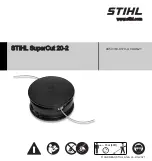
Functional Description
If occupation is detected by the permanently active PIR sensor,
a radio telegram indicating the occupied status will transmit
immediately. A motion transmission interval timer starts to run
with a variable timer length varying between 60 and 300 sec-
onds, depending on the light level. No radio telegrams will be
sent out until the timer expires.
After the timer has expired, the unit will transmit again if occu-
pancy was detected during the timer interval period. If occu-
pancy was not detected, the unit will transmit a heartbeat signal
- sending the unoccupied heartbeat status message every 2 - 11
minutes (depending on the light level).
Planning
Take a moment to plan for the sensor’s successful operation and
optimal communication with other system components.
Remove the sensor from its packaging and place it under a
bright light to provide the required startup charge. Optionally,
to ensure the sensor energy storage is fully charged, insert a
CR2032 battery for 5 minutes while in a well-lit location.
▪
Ensure the location provides consistent and adequate light
▪
Install with the appropriate lens for the required coverage
▪
Locate the sensor between 6 and 8 ft (1.8 to 2.4 m) high with
an unobstructed view of the space
▪
For wide angle coverage, locate the sensor where traf
fi
c
moves across the detection pattern, not in and out
▪
Consider the area’s traf
fi
c patterns and principal use, for
example, walking, lounging or sleeping
▪
Provide a minimum clearance of 4 ft. (1.2 m) away from heat
sources, light bulbs, forced air, or ventilation systems
▪
Consider the construction materials (such as metal) in the
space and obstacles that may interfere with RF signals
Sensor Range
A single occupancy sensor provides suf
fi
cient coverage for most
applications. For some applications, multiple sensors may be
required to provide complete coverage.
Wide Angle Coverage
0
33 ft (10 m)
16 ft (5 m)
16 ft (5 m)
Top View
6.8 ft
(2.1 m)
6 ft
15 ft
25 ft
50 ft
Side View
33 ft (10 m)
Long Range Coverage
16 ft
0
16 ft
8 ft
8 ft
Top View
27°
77°
21.5°
14°
6.5°
center line
Side View
6.8 ft
(2.1 m)
3 ft
(1 m)
7 ft
(2.2 m)
10 ft
(3 m)
35 ft
(10.7 m)
60 ft
(18.3 m)
100 ft
(30.5 m)
Installing
The mounting plate can be installed
fl
ush to the wall or angled
in a corner.
NOTE: It is often easier to link the sensor before it is mounted
on the wall. Refer to the Linking section.
1. Remove the mounting plate from the sensor assembly by
pressing the release tab located on the top of the sensor.
2. Decide which of the two installation options is appropriate:
A. Flush to the Wall
i. Orient the mounting plate
using the pencil marks.
Mark the two mounting
screw drill points.
ii. Drill two holes with a 3/16”
bit and insert wall anchors.
iii. Insert the
fi
rst screw
loosely and level the mounting plate.
iv. Insert the 2nd screw then hand-tighten the 1st screw.
B. Angled in a Corner
i. Orient the mounting plate
using the pencil marks.
ii. Carefully drill through two of
the four blind holes on the
angled sides of the mounting
plate (one on each side).
iii. Mark the two mounting screw
drill points and drill two pilot holes with a 3/16”
drill bit and insert the wall anchors.
iv. Insert the two screws and hand-tighten them.
3. Fit the sensor into the groove at the bottom of the mounting
plate and close the top.
p
p
estimated time: 20 minutes
Occupancy Sensor – Wall Mounted • Installation Guide
Page 2
© 2013 Hubbell Building Automation | www.hubbell-automation.com






















